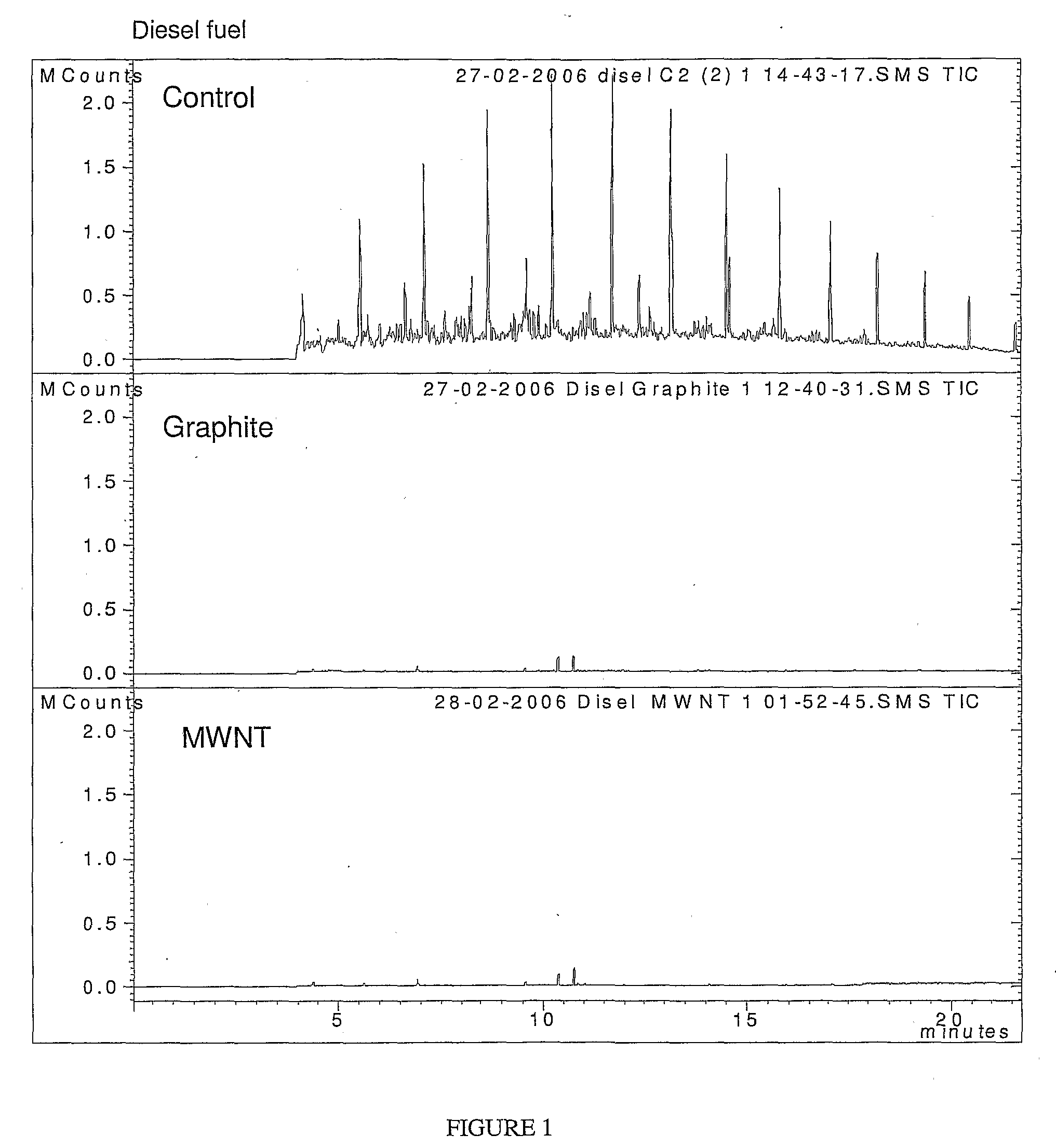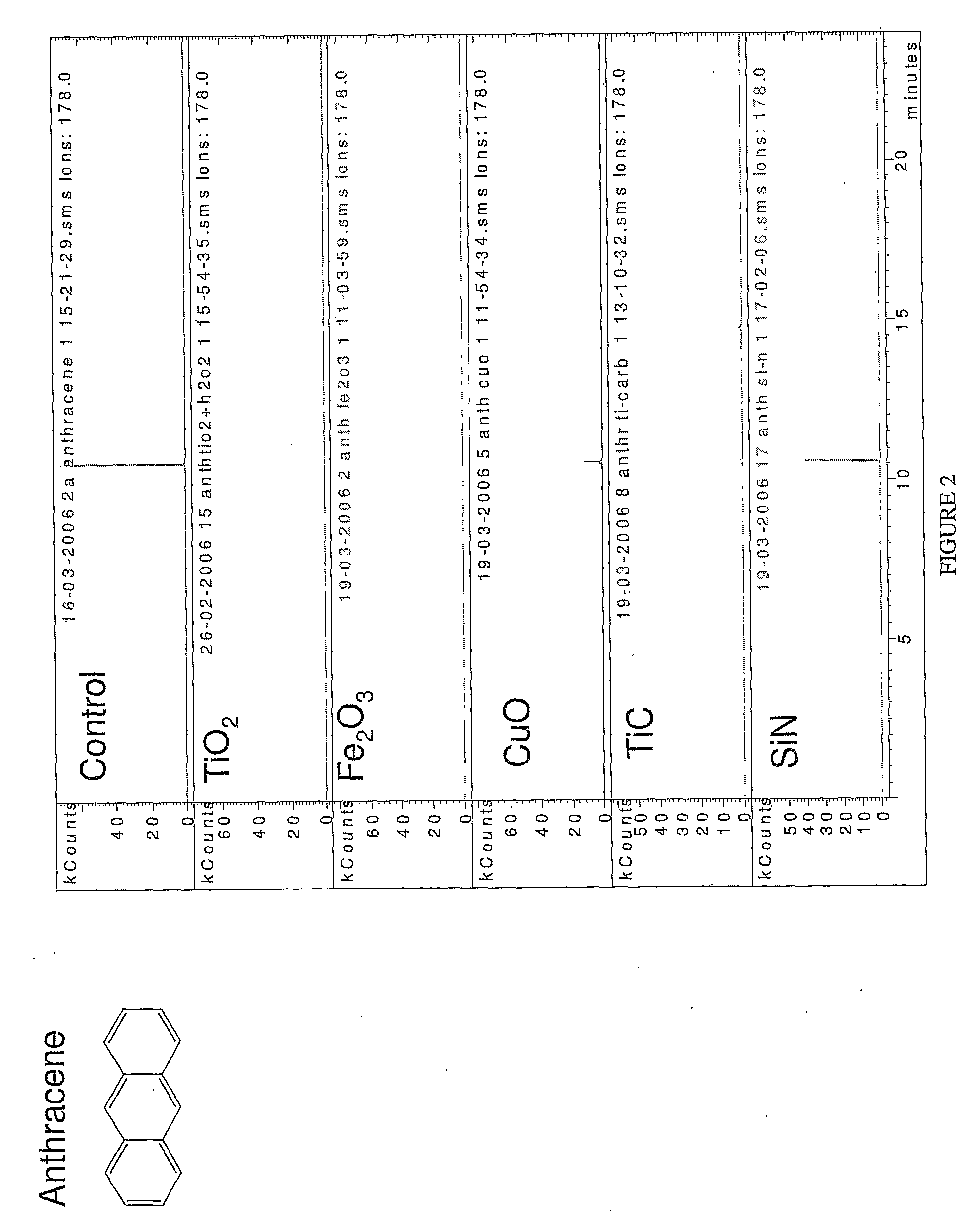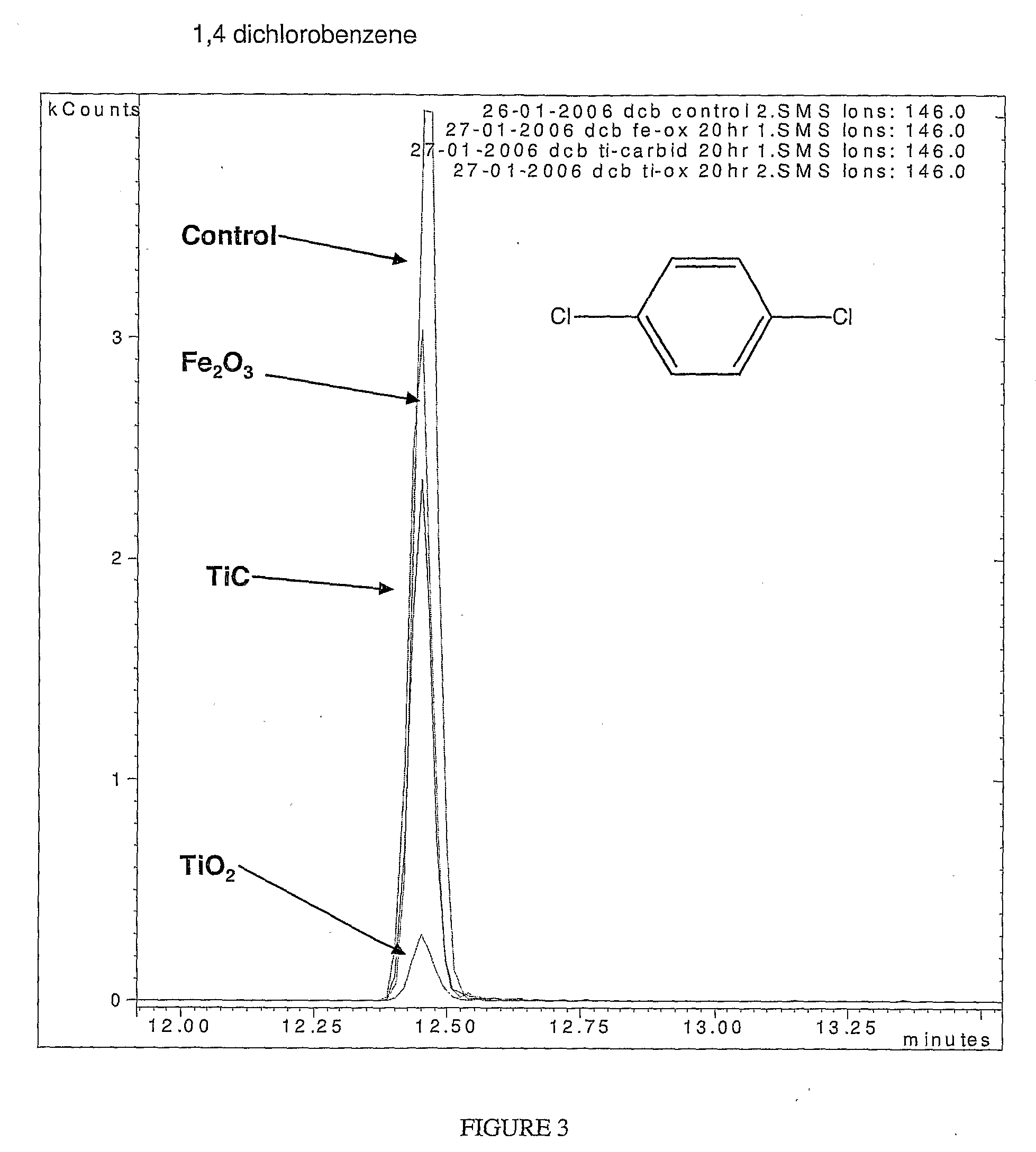Decontaminating fluids and methods of use thereof
a technology for decontaminating fluids and materials, applied in the direction of multi-stage water/sewage treatment, other chemical processes, separation processes, etc., can solve the problems of high toxic byproducts, limited treatment methods, and ineffective decontamination of solids and fluids
- Summary
- Abstract
- Description
- Claims
- Application Information
AI Technical Summary
Problems solved by technology
Method used
Image
Examples
example 1
Decontamination of Monochlorobenzene and Dichlorobenzene
Materials and Methods
Reagents:
[0296]Monochlorobenzene, dichlorobenzene, Fe3O4 Iron (II,III) oxide nanopowder, >98%, 20-30 nm, BET (Brunauer, Emmett and Teller) surface area >60 m2 / g, Sigma-Aldrich cat# 637106; TiO2 Titanium(IV) oxide nanopowder, 99.9% 25-70 nm avg. particle size (xrd), BET surf. area 20-25 m2 / g Sigma-Aldrich cat# 634662; TiC Titanium (IV) carbide nanopowder, >98% 130 nm avg. particle size BET surf. area 25-45 m2 / gm Sigma-Aldrich cat #636967, were all purchased from Aldrich. H2O2 / H20 was employed at a concentration of 30% v / v Merck, Germany.
Process:
[0297]Iron oxide nanoparticles (0.1 g) were suspended in an aqueous solution (15 mL) containing 50 mg / L monochlorobenzene. Subsequently 2 mL of H2O2 30% was added. The reaction mixture was stirred in a sealed 50 mL reactor for 48-72 h at room temperature. The nanoparticles were filtered off and ready for reuse. The aqueous reaction solutions were extracted by toluene ...
example 2
Various Examples of Decontamination
Materials and Methods
Reagents:
[0300]Copper oxide, iron oxide, titanium oxide, titanium carbide, zinc oxide, silicon nitride, Lindane; polyaromatic hydrocarbons (PAHs) [e.g., naphthalene, phenanthrene, anthracene] were purchased from Sigma-Aldrich. Tribromoneopentyl alcohol (TBNPA); Tribromophenol (TBP) were received from Dead Sea Bromine Group (DSBG). Diesel fuel and gasoline were purchased in a gas station. H2O2 / H2O was employed at a concentration of 30% v / v Merck, Germany.
Process:
[0301]Copper oxide nanoparticles (0.1 g) were suspended in an aqueous solution (15 mL) containing 50 mg / L tribromoneopentyl alcohol. Subsequently, 2 mL H2O2 30% was added. The reaction mixture was stirred in a sealed 50 mL reactor for 48-72 hours at room temperature. The nanoparticles were filtered off and ready for reuse. The aqueous reaction solutions were extracted by toluene or dichloromethane (by mixing the reaction vial content with 3 mL solvent) and the extract wa...
example 3
Decontamination of Phenanthrene and Alachlor
Reagents:
[0316]2-chloro-2′,6′-diethyl-N-methoxymethylacetanilide (Alachlor) was provided by Agan Chemical Manufacturers. Phenanthrene, CuO copper (II) oxide nanopowder, 33 nm, BET (Brunauer, Emmett and Teller) surface area 29 m2 / g, cat# 544868, were purchased from Sigma-Aldrich. H2O2 / H2O was employed at a concentration of 30% v / v Merck, Germany.
Process:
[0317]Copper oxide nanoparticles (0.2 g) were suspended in an aqueous solution (200 mL) containing 30 mg / L alachlor. Subsequently 2 mL of H2O2 30% was added. The reaction mixture was sonicated in a 250 mL reactor for 30 minutes at room temperature.
[0318]Samples of the reaction solution were taken at different times and then extracted by n-hexane (by mixing 3 mL of the solution with 3 mL solvent). The extracts were injected to the GC to determine the concentration of alachlor. This process was repeated for phenanthrene (0.5 mg / L) using copper oxide nanoparticles (0.1 g).
[0319]In order to test...
PUM
| Property | Measurement | Unit |
|---|---|---|
| Fraction | aaaaa | aaaaa |
| Molar density | aaaaa | aaaaa |
| Volume | aaaaa | aaaaa |
Abstract
Description
Claims
Application Information
 Login to View More
Login to View More - R&D
- Intellectual Property
- Life Sciences
- Materials
- Tech Scout
- Unparalleled Data Quality
- Higher Quality Content
- 60% Fewer Hallucinations
Browse by: Latest US Patents, China's latest patents, Technical Efficacy Thesaurus, Application Domain, Technology Topic, Popular Technical Reports.
© 2025 PatSnap. All rights reserved.Legal|Privacy policy|Modern Slavery Act Transparency Statement|Sitemap|About US| Contact US: help@patsnap.com



